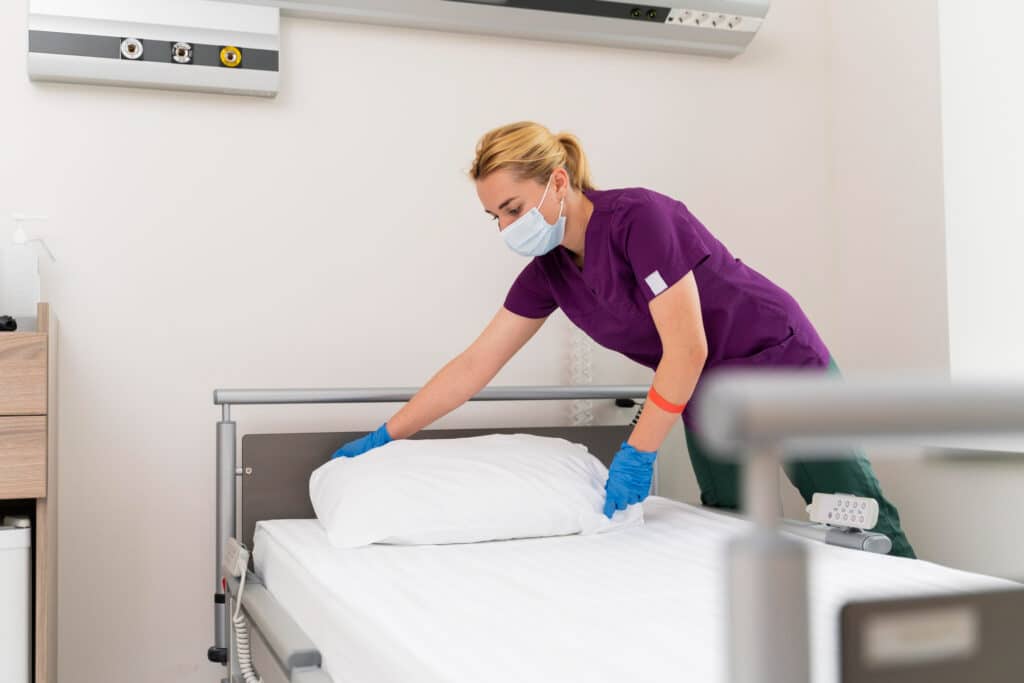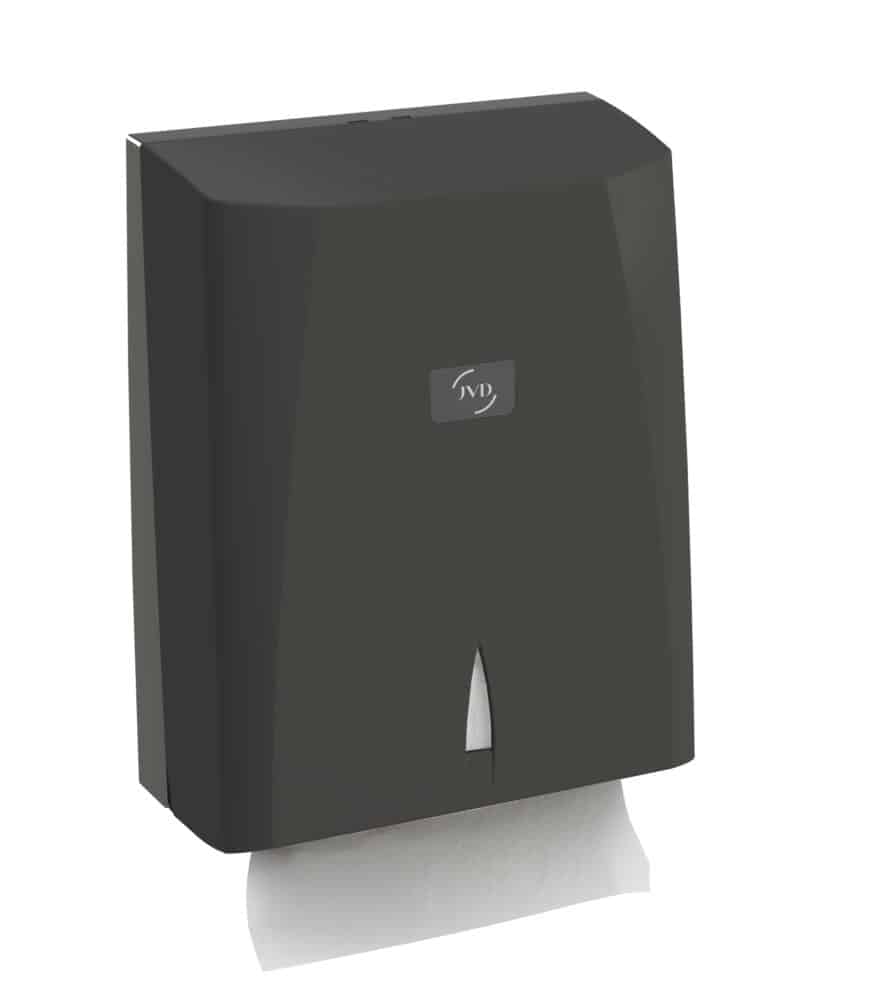Hospital cleaning is a crucial process to ensure health safety. This rigorous technique aims to eliminate pathogens and infectious agents, particularly in the healthcare sector.
In 2023, technological advancements are progressing rapidly, gradually transforming cleaning methods. To address the decrease in personnel, digitizing the monitoring of hospital cleaning has become imperative. Let’s take a closer look at the new technologies for managing medical hygiene!
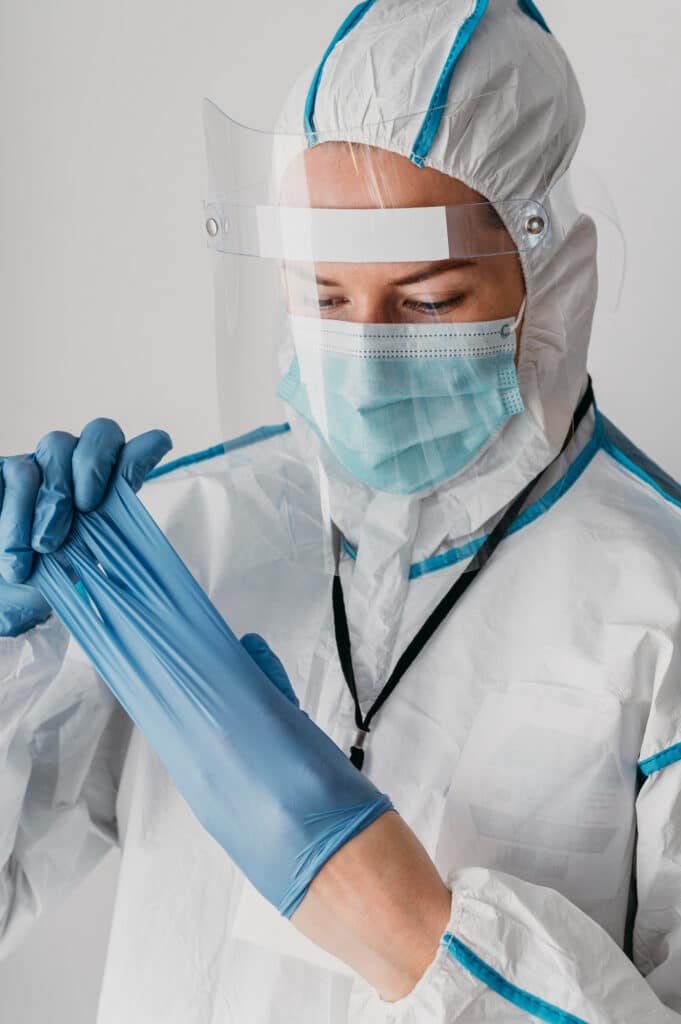
Hospital cleaning : evolution and limitations
Hospital cleaning involves a series of protocols used in sensitive medical environments. Healthcare facilities implement cleaning interventions to prevent the spread of nosocomial infections.
With the emergence of highly contagious viruses such as COVID-19, ensuring the completion of cleaning services is crucial. Now, monitoring these interventions is a significant challenge.
The challenges of medical hygiene
Hospital cleaning is one of the pillars that protect patients’ health. Indeed, this strict method slows down the proliferation of harmful organisms present on surfaces and in spaces.
Therefore, poorly executed hospital cleaning can lead to an increased risk of infections. This rise in infections can then be a vector for medical complications and may prolong patients’ hospital stays. Repeated exposure to pathogens can also contribute to rendering treatments less effective. Healthcare facilities thus expose themselves to legal action in cases of superinfections.
Furthermore, an infected work environment can result in absences of medical staff. The lack of hospital cleaning consequently compromises the quality of care. Human resources are reassigned, leading to disorganized overall care management.
In conclusion, inadequate hospital cleaning significantly damages the reputation of the healthcare facility. This results in increased financial costs, a decrease in patient attendance, and a loss of public trust. Patient and visitor satisfaction is low, and the hospital experience is perceived negatively.
The limitations of manual monitoring of hospital cleaning
In many medical facilities, hospital cleaning interventions are manually tracked. A post-it is exchanged between departments, a note is left on a desk, or teams are informed through dozens of calls. Even computerized tracking on Excel is insufficient. These conditions do not promote traceability of information in any way.
Hospital cleaning is either managed internally or outsourced. In both cases, the absence of digital tracking of interventions poses a problem. Data entry errors, omissions, incorrect interpretations, and data losses can easily occur! Without control of the services, the healthcare center cannot guarantee compliance with mandatory regulations.
Furthermore, the lack of digitalization in tracking hospital cleaning can delay the detection and resolution of problems on the ground. Manual tracking slows down communication between cleaning teams, managers, and medical staff. In the event of unforeseen circumstances, protocols are not adjusted in real time, thus exposing patients to danger. Managers do not have access to situation reports and therefore cannot identify areas for improvement.
The new technologies of hospital cleaning
Following the health crisis, quality and compliance have become increasingly important in healthcare facilities. Now, medical institutions are seeking reliable tools to track and manage their hospital cleaning interventions.
The challenge is twofold: ensuring a healthy environment for patients and maintaining the mandatory regulations to operate. With successive technological innovations, new devices have appeared on the market. With these tools, performance, time savings, and cost reduction are achievable!
Automation and robotization
Since the digitization of certain processes, hospital cleaning has taken a whole new direction. Autonomous robots have invaded hospital corridors, interventions trigger automatically, and everything is remotely controlled.
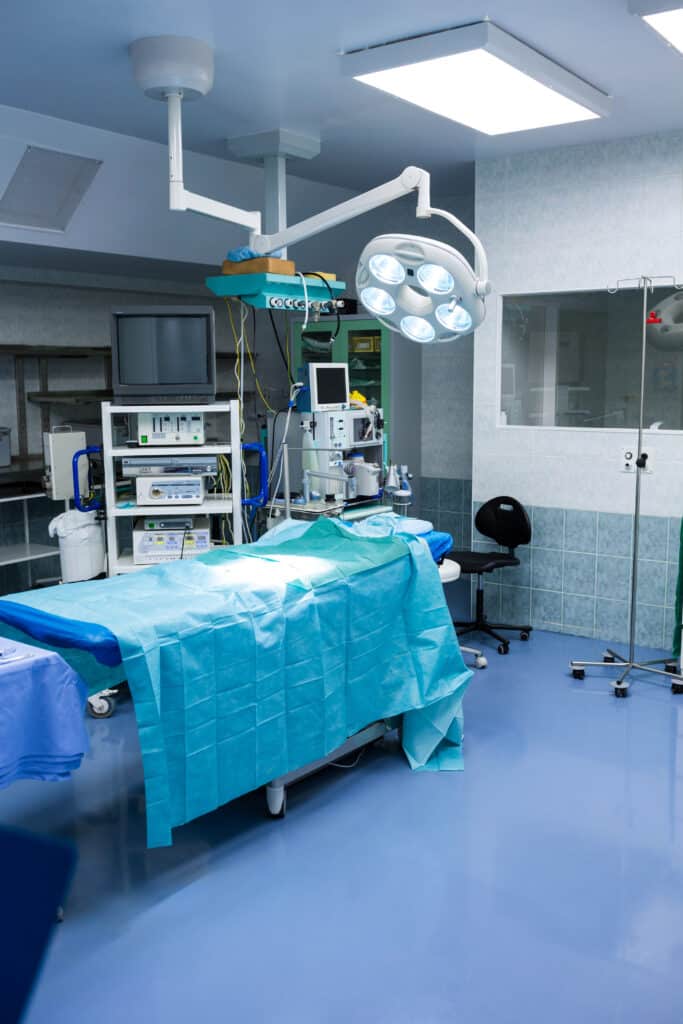
On one hand, cleaning robots bring a series of undeniable advantages for agents. These devices are experts in precision. They follow preprogrammed trajectories or adapt their route in real-time based on the environment. The result? Forgotten corners and hard-to-reach areas are no longer a concern. Hospital cleaning protocols are meticulously followed, ensuring a consistent and reliable level of quality.
On the other hand, automation doesn’t stop at physical cleaning; it also extends to intervention management processes. Gradually, healthcare facilities are adopting integrated platforms that manage intervention requests in real-time. Out of consumables? A restocking is triggered instantly. A patient receives discharge clearance? A cleaning intervention is scheduled within minutes.
Furthermore, digitized intervention scenarios enable optimal allocation of resources. By analyzing the nature of the intervention, the location, and the availability of agents, the platform assigns the task to the competent professional and minimizes intervention delays. By grouping interventions geographically close, routes are shortened, travel times are optimized, and costs are controlled.
Connected devices and IoT sensors: allies of hospital cleaning
The era of connected technology has opened up new perspectives in the field of hygiene and cleanliness. Sensors and connected objects have emerged as powerful tools for monitoring and improving cleaning interventions in healthcare environments.
By integrating these smart sensors, healthcare facilities obtain real-time field data. From the level of hand sanitizer at reception to the number of people in the emergency room, and the air quality in intensive care units, all these indicators promote proactive operational management.
Furthermore, data collection enables the instant detection of anomalies. Managers can react promptly to changes and ensure continuous service. The collected data also allows for trend analysis, identification of weak points, and implementation of automated corrective actions.
Among the useful IoT objects and sensors are:
- Counting and passage sensors: These ingenious devices capture every entry and exit. Counting data provides an overview of the busiest areas. Managers can thus plan interventions based on occupancy levels. This approach ensures hospital cleaning at the right time, in the right place, and only when necessary.
- Environmental sensors: Air quality, humidity, fine particles, CO2… These devices monitor indicators of the medical environment. This data allows for the rapid detection of variations, particularly in enclosed spaces. Managers can then trigger ventilation, aeration, or cleaning interventions to ensure a healthy indoor environment.
Équipements d’hygiène connectée : Ces dispositifs mesurent en temps réel la contenance de vos distributeurs ou poubelles. Lorsque le seuil est bas ou la poubelle est pleine, une alerte est envoyée immédiatement à vos agents. Ils peuvent ainsi intervenir pour éviter les ruptures de service. La satisfaction des patients est ainsi entretenue.
Tablette connectée : Ces outils intégrés aux chariots de bionettoyage apportent une nouvelle dimension à l’efficacité opérationnelle. Grâce à des applications conçues pour la gestion des interventions, les agents de nettoyage ont désormais accès à des listes de tâches détaillées et à jour en temps réel. Ces listes sont adaptées à chaque emplacement, indiquant les zones à nettoyer, les produits à utiliser et les étapes spécifiques à suivre. Les agents
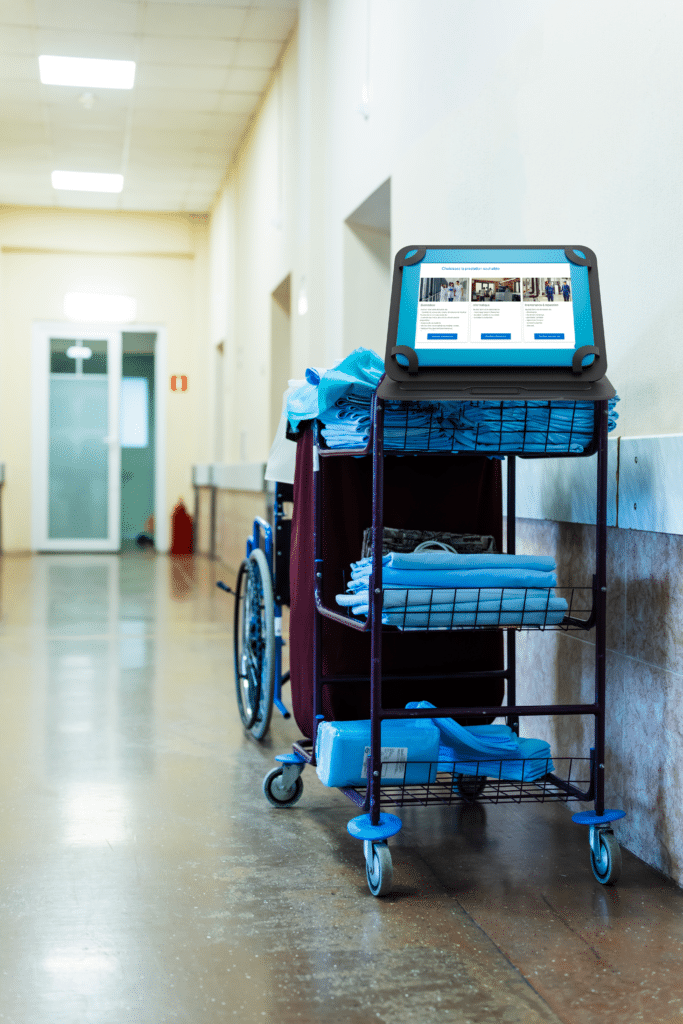
They can validate completed tasks in real-time, ensuring accurate tracking of the progress of hospital cleaning. Messages, instructions, and updates can also be transmitted instantly.
Software for tracking hospital cleaning
Software for tracking hospital cleaning has become the guarantor of a safe environment. These integrated platforms centralize all information related to hospital cleaning processes. They connect field agents, managers, and caregivers in a transparent management ecosystem.
Moreover, these software solutions enable real-time planning, monitoring, and tracking of cleaning tasks. The use of QR codes, NFC tags, or connected tablets triggers interventions and collects data at each step. Agents scan the codes to indicate the start and end of each task and report their progress through digital checklists. Managers can monitor this information live, visualizing cleaned areas, execution times, and any anomalies.
Standardized procedures and access to detailed checklists reduce errors and improve service quality. Managers can track the performance of each agent, adherence to protocols, and compliance with regulations.
Artificial Intelligence: an innovation that is growing

Since late 2022, artificial intelligence (AI) has brought unprecedented precision and prevention capabilities to the operational environment.
Hospital cleaning tracking software collects a multitude of real-time data. AI then acts as a powerful analytical tool. With sophisticated algorithms, AI identifies trends and establishes correlations between the data.
One of the major benefits of AI is its ability to predict malfunctions. By analyzing historical data, this technology can anticipate areas at risk of infection, resource needs, and staffing requirements.
AI also proves useful in preventing nosocomial infections. By analyzing infection statistics, AI can identify patterns of occurrence and risk factors. It can also recommend preventive measures, protocol changes, or adjustments in hospital cleaning practices.
MoveWORK Flow, the hospital cleaning tracking software
MoveWORK Flow is an all-in-one solution designed to optimize and digitize your hospital cleaning procedures and their tracking. This integrated solution brings together several key features for your healthcare facility: intervention tracking, quality management, KPI analysis… From intervention planning to monitoring health indicators, each step is harmonized within a single interface.
The key features
MoveWORK Flow enables complete traceability of cleaning interventions. Field agents report their presence and actions in real-time, providing instant visibility into task progress. This feature enhances coordination and communication between teams, ensuring efficient execution in accordance with protocols.
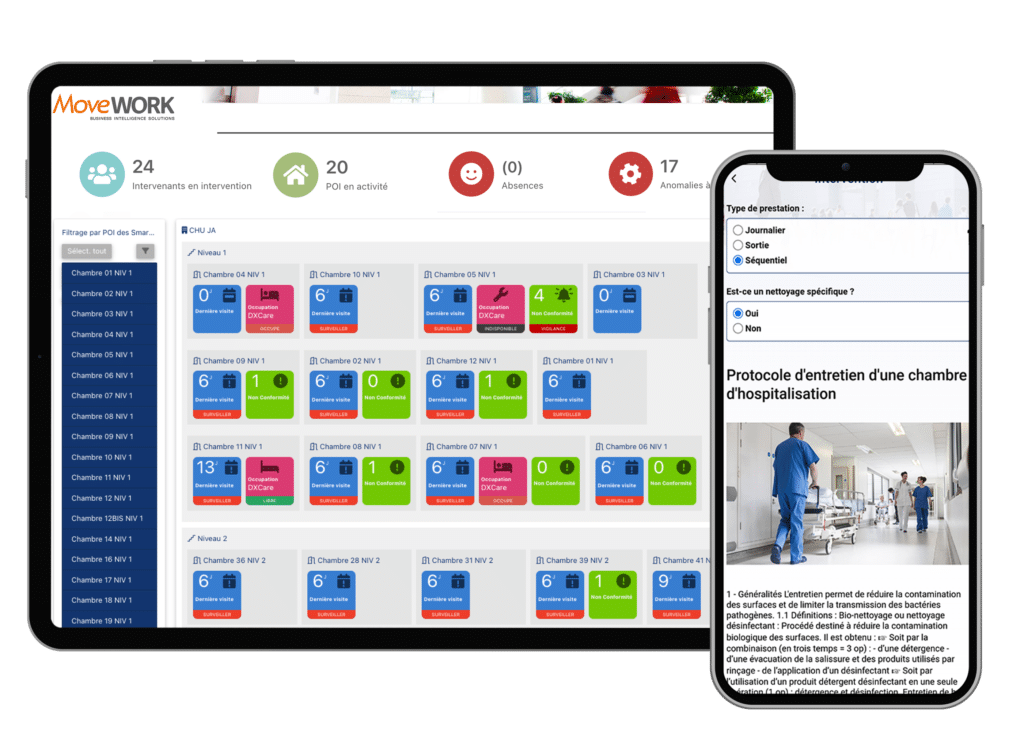
MoveWORK Flow revolutionizes quality control by automating checks. Specific indicators are defined for each area and task, ensuring that hygiene standards are met. The digitization of processes eliminates tedious manual tasks, thereby reducing the risks of errors and omissions. In case an acceptable threshold is not met, immediate corrective actions are triggered.
Furthermore, the platform offers customizable dashboards that provide a clear and concise operational view. Performance indicators are centralized in dynamic graphs, updated in real-time.
Hospital cleaning: the advantages of MoveWORK Flow
MoveWORK Flow offers a multitude of benefits for healthcare facilities. By automating and optimizing cleaning processes, the platform helps minimize the risks of nosocomial infections. Real-time monitoring, automated quality controls, and intervention coordination ensure a safer environment for patients and staff.
Through digitized management, healthcare facilities experience a significant improvement in operational efficiency. Agents can focus on essential tasks, while managers have clear visibility to make strategic decisions.
Finally, MoveWORK Flow ensures compliance with health standards and facilitates obtaining HAS certifications. Traceable data, along with reports generated by the platform, strengthen the documentation and transparency necessary to meet regulatory requirements.
